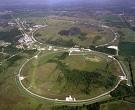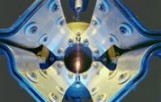GRAPHALLOY®
Solves A Proton Beam Problem
The Fermi National Accelerator Laboratory (Fermilab) is a Department  of Energy atomic particle research lab in Batavia, IL. Fermilab specializes in high energy physics research and devotes much of their efforts toward understanding the basic properties of fundamental particles including neutrinos and other subatomic particles. of Energy atomic particle research lab in Batavia, IL. Fermilab specializes in high energy physics research and devotes much of their efforts toward understanding the basic properties of fundamental particles including neutrinos and other subatomic particles.
Fermilab recently turned to GRAPHALLOY® bearings to solve a problem in a critical "neutrino target adjustment" mechanism when previous solutions had failed.
Fermilab's MINOS (Main Injector Neutrino Oscillation Search) is designed to observe neutrino beam composition and energy distribution as it travels underground from Fermilab in Illinois to the Soudan Iron Mine in Minnesota. Neutrinos produced by the particle accelerator at Fermilab are "beamed" 450 miles through the earth.
To produce this beam of neutrinos, a proton beam starts at the Main Injector accelerator. The protons are magnetically focused onto a target. Once  the protons strike the target, secondary particles are produced, focused by a pair of magnetic focusing "horns". The particles of interest then decay into neutrinos. It is the mechanical adjustment of these focusing horns that requires GRAPHALLOY bearings. the protons strike the target, secondary particles are produced, focused by a pair of magnetic focusing "horns". The particles of interest then decay into neutrinos. It is the mechanical adjustment of these focusing horns that requires GRAPHALLOY bearings.
This operation runs in a particularly hostile environment. It is radioactive and corrosive and is exposed to nitric acid and ionized air. Metallic bushings cannot be used. In addition, polymers, organics, plastics and oil cannot be used in the operation. Finally, the bearings must run dry.
The unique properties of GRAPHALLOY provided the solution to this application. GRAPHALLOY bushings were used to target and position the horns because other materials would corrode and freeze up.
This is an excellent example of how GRAPHALLOY can solve problems under harsh operating conditions.
(Images courtesy of Fermilab Visual Media Services)
 Click here to download this case history Click here to download this case history
|